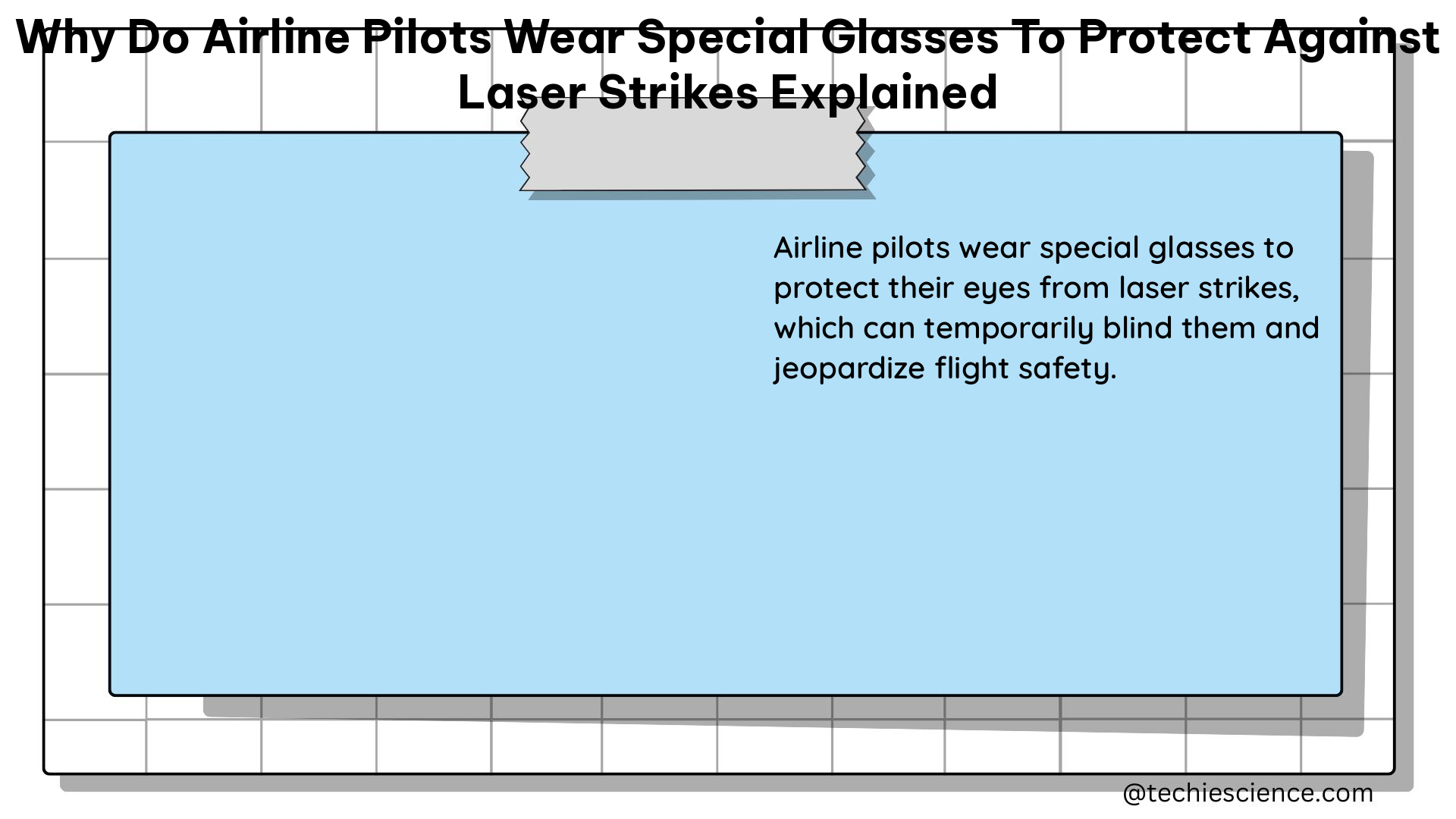Airline pilots wear specialized glasses, known as laser safety glasses or laser strike eyewear, to safeguard their eyes from the hazardous effects of laser strikes. These strikes are caused by handheld lasers, which are becoming increasingly affordable and accessible, and can temporarily blind or distract pilots, posing a significant threat during critical flight phases such as takeoff and landing. In 2023, there were over 7,000 reported laser strikes on aircraft in the US alone, with an average of eleven strikes per day in 2014.
The Science Behind Laser Safety Glasses
Laser safety glasses are designed to block and reduce the wavelengths of laser beams, protecting pilots from the harmful effects of laser strikes. The unique absorption of the wavelength of light in these glasses offers complete protection from all three laser color spectrums, determined by wavelength.
Laser Wavelengths and Their Effects
The most prevalent wavelengths of lasers seen by pilots are:
- Green (87%)
- Violet-blue (9%)
Laser strikes can cause the following issues:
- Loss of situational awareness
- Loss of vision and the ability to see instrumentation due to glare
- Risk of temporary and permanent eye injury
Laser Protective Eyewear: CALI System
To address these issues, researchers at the Air Force Research Laboratory (AFRL) developed a new set of laser protective eyewear called CALI (Commercial Aviation Low Intensity). The CALI system filters the precise wavelength of light needed to block the most threatening lasers without blocking adjacent colored wavelengths, all while transmitting much more visible light than a traditional set of laser eye protection (LEP).
CALI System Specifications
- Wavelength Filtering: The CALI system is designed to filter the specific wavelengths of light that are most commonly used in laser strikes, without blocking adjacent colored wavelengths.
- Visible Light Transmission: The CALI system transmits much more visible light than traditional LEP, allowing pilots to maintain situational awareness and visual clarity during flight.
- Durability: The CALI system is designed to be lightweight and durable, with a reliable one-year warranty against manufacturer defects.
Laser Safety Glasses: Frame Options
Laser safety glasses are available in various frame options to suit the needs of airline pilots. These frames are designed to be lightweight and durable, ensuring comfort and protection during flight.
Frame Materials
- Polycarbonate: Lightweight and impact-resistant material, commonly used in safety glasses.
- Nylon: Durable and flexible material, providing a comfortable fit.
- Metal: Offers a more traditional and professional appearance, while maintaining durability.
Frame Styles
- Wraparound: Provides comprehensive coverage and protection from peripheral light sources.
- Rectangular: Offers a classic, streamlined appearance.
- Aviator: Combines style and functionality, with a distinctive shape that is popular among pilots.
Laser Strikes: A Growing Concern

Laser strikes on aircraft are a growing concern, with the number of reported incidents increasing in recent years. In 2023, there were over 7,000 reported laser strikes on aircraft in the US alone, with an average of eleven strikes per day in 2014.
Factors Contributing to Laser Strikes
- Availability of Handheld Lasers: Handheld lasers are becoming increasingly cheap and easy to obtain, making them more accessible to the general public.
- Lack of Awareness: Many individuals may not be aware of the dangers and legal consequences associated with aiming lasers at aircraft.
- Intentional Targeting: In some cases, laser strikes may be intentional, with the aim of disrupting or distracting pilots.
Consequences of Laser Strikes
Laser strikes can have severe consequences for pilots and aircraft operations, including:
- Temporary Blindness: Laser beams can temporarily blind pilots, causing a loss of vision and the ability to see instrumentation.
- Distraction: Laser strikes can distract pilots, leading to a loss of situational awareness and increased risk of accidents.
- Eye Injury: Prolonged exposure to laser beams can cause temporary or permanent eye damage, including retinal burns and vision impairment.
Conclusion
Airline pilots wear specialized laser safety glasses to protect their eyes from the growing threat of laser strikes. These glasses are designed to block and reduce the wavelengths of laser beams, offering complete protection from all three laser color spectrums. The CALI system, developed by the AFRL, is a cutting-edge solution that filters the precise wavelengths of light needed to block the most threatening lasers while maintaining high visible light transmission.
As the availability of handheld lasers continues to increase, the importance of laser safety glasses for airline pilots cannot be overstated. These specialized glasses play a crucial role in safeguarding pilots and ensuring the safety of air travel, particularly during critical phases of flight.
Reference:
– Phillips Safety: Laser Strike Eyewear for Pilots
– Revision Military: Protection at Altitude Laser Eyewear
– Safety Glasses USA: Laser Protection for Pilots

The lambdageeks.com Core SME Team is a group of experienced subject matter experts from diverse scientific and technical fields including Physics, Chemistry, Technology,Electronics & Electrical Engineering, Automotive, Mechanical Engineering. Our team collaborates to create high-quality, well-researched articles on a wide range of science and technology topics for the lambdageeks.com website.
All Our Senior SME are having more than 7 Years of experience in the respective fields . They are either Working Industry Professionals or assocaited With different Universities. Refer Our Authors Page to get to know About our Core SMEs.